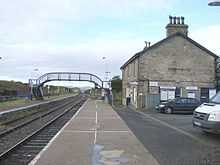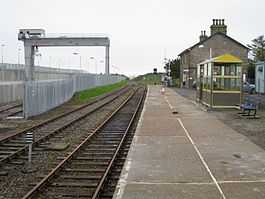Georgemas Junction railway station
| Georgemas Junction | |
|---|---|
|
Looking west towards Halkirk village and the line to Thurso (right) | |
| Location | |
| Place | Halkirk |
| Local authority | Highland |
| Coordinates | 58°30′49″N 3°27′06″W / 58.5135°N 3.4518°WCoordinates: 58°30′49″N 3°27′06″W / 58.5135°N 3.4518°W |
| Grid reference | ND155592 |
| Operations | |
| Station code | GGJ |
| Managed by | ScotRail |
| Number of platforms | 1 |
|
Live arrivals/departures, station information and onward connections from National Rail Enquiries | |
| Annual rail passenger usage* | |
| 2002/03 | 1,129 |
| 2004/05 |
|
| 2005/06 |
|
| 2006/07 |
|
| 2007/08 |
|
| 2008/09 |
|
| 2009/10 |
|
| 2010/11 |
|
| 2011/12 |
|
| 2012/13 |
|
| 2013/14 |
|
| History | |
| 1874 | Opened |
| National Rail – UK railway stations | |
| * Annual estimated passenger usage based on sales of tickets in stated financial year(s) which end or originate at Georgemas Junction from Office of Rail Regulation statistics. Methodology may vary year on year. | |
| UK Railways portal | |
Georgemas Junction railway station is a railway station serving the village of Halkirk and its surrounding areas in the Highland council area, northern Scotland. The station is on the Far North Line, within the historic county of Caithness. Georgemas Junction is the junction of the Thurso branch from the Inverness-Wick line, the most northerly railway junction in the United Kingdom.
History
The station was built by the Sutherland and Caithness Railway (S&CR). It opened on 28 July 1874 and on that date the Highland Railway absorbed the S&CR and operated the newly completed line from Helmsdale to Thurso and Wick. From 1 January 1923 the station was operated by the London Midland and Scottish Railway.
Operation

Until diesel multiple unit trains were introduced by British Rail in the early 1990s, all trains on the Far North Line were locomotive hauled, initially by Highland Railway steam locomotives, then by LMSR steam locomotives and latterly by British Railways steam and finally Class 37 diesel locomotives. Northbound passenger trains would divide at Georgemas Junction, with the rear portion for Thurso and the front portion for Wick. A locomotive was stabled at Georgemas Junction to haul the Thurso carriages.
Following the introduction of Class 156 diesel multiple units on the line, trains were always composed of two trainsets (four cars) and at Georgemas, these would split in half with the front portion heading to Wick, the rear to Thurso.
This practice was halted with the introduction of Class 158 sets which operated as single sets. On arrival at Georgemas Junction from Inverness trains reverse to reach Thurso, they then operate from Thurso back to Georgemas Junction and on to Wick. An easement to the National Routeing Guide allows passengers for Wick to stay on the train between Georgemas Junction and Thurso, which would otherwise technically be off-route.[1]
Georgemas Junction has been used for several freight services. In the early 2000s, EWS operated a freight train for Safeway supermarket, running from Mossend to Georgemas. Containers were unloaded at Georgemas, then transported by road to Wick and Thurso, and by ferry to Orkney.[2]
In 2012, Direct Rail Services constructed a new freight terminal at Georgemas. This has been used by trains taking nuclear material from Dounreay to Sellafield.[3]
| Preceding station | |
Following station | ||
|---|---|---|---|---|
| Scotscalder or Forsinard |
ScotRail Far North Line |
Thurso | ||
| Wick | ||||
| Historical railways | ||||
| Halkirk station closed; line open |
Sutherland and Caithness Railway Highland Railway |
Bower station closed; line open | ||
| Hoy station closed; line open | ||||
References
Notes
- ↑ http://www.atoc.org/clientfiles/File/RSPDocuments/easements.pdf
- ↑ "Supermarket containers being unloaded at Georgemas Junction, 2001". Am Baile. Highland Council.
- ↑ "Rail terminal is a major boost". John O'Groat Journal. 27 June 2012. Retrieved 26 February 2013.
Sources
- Butt, R. V. J. (1995). The Directory of Railway Stations: details every public and private passenger station, halt, platform and stopping place, past and present (1st ed.). Sparkford: Patrick Stephens Ltd. ISBN 1-8526-0508-1. OCLC 60251199.
- Jowett, Alan (March 1989). Jowett's Railway Atlas of Great Britain and Ireland: From Pre-Grouping to the Present Day (1st ed.). Sparkford: Patrick Stephens Ltd. ISBN 1-8526-0086-1. OCLC 22311137.
- ScotRail North Highlands Timetable
| Wikimedia Commons has media related to Georgemas Junction railway station. |
